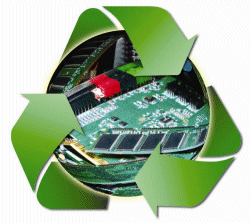When I was a kid, in the late 1950s, early 60s, my dad was a TV repairman. We lived behind his shop, so I got to help him around the shop. I would hold the solder as he removed a resistor or capacitor. I helped customers use the tube tester on the counter. I dismantled old TVs, using a wire clipper to remove resistors, capacitors, coils, and other small components and put them in coffee cans for future use. I would put vacuum tubes away carefully.

As I look back, a lot of what my dad did then was aimed at recycling, although we didn’t call it that at the time. I suppose he reused the components in the coffee cans, although my mother reminded me that when my dad died in the mid-1980s a lot of that stuff was given away to other electronics buffs and probably eventually thrown away.
My dad would also fix old TVs for the family, another example of reusing. The sets were black and white, but they were freeoften taken from the trash on garbage-pickup days, thrown out by average people who didn’t have a clue how to fix them. My dad did this so often that I didn’t own a new TV, in fact, a color TV, until after he died.
I probably should mention that my dad stopped fixing TVs in his shop about the time color–and printed circuit boards–came along. He never got into the new generation of repair that involved simply replacing whole boards–no more soldering single components, no more vacuum tubes–everything transistors, solid state.
The newer TVs needed less repair, because the circuit boards really were more reliable than all the individual components. That was, and is, true of all electronic devices. At the same time, when something broke you didn’t get it fixed; you just bought new. It didn’t matter that you knew what was wrong; if it was inexpensive enough, it didn’t pay to fix a device–you had to buy new.
A lot of things just went into the trash, in spite of First Lady Lady Bird Johnson’s Keep America Beautiful campaign. That campaign succeeded in closing a lot of neighborhood junk yards, which was where we kids sold collected newspapers ($1 per 100 lbs is a price I remember) and metals (I forget the prices).
The 1960s ended, and in 1970 the first Earth Day was “celebrated” (I’m not sure that’s the right word). Our society was, and is, a consumer society, and Earth Day’s concept of recycling, reusing, and reducing is quite foreign to consuming.
Nevertheless, we are really hurting the environment around us, and we cannot live in the past. The coffee cans of 40 or 50 years ago are today sites like eBay (www.ebay.com) or Craig’s List (www.craigs-list.com). The reminders to turn things off when you are not using them are much more gentle than your parents yelling stuff about being related to Edison or having stock in the electric company. Today the reminders are built into modern appliances, which have sleep modes and EnergyStar labels that promise that they’ll talk to your parents for you in the form of lower electric bills. And unwanted electronics can be put on the curb weekly, with their plastics and metals appropriately recycled. Increasingly, we don’t need to clutter our lives or our landfills.
Len Schiefer
Advertisement
Learn more about Electronic Products Magazine





